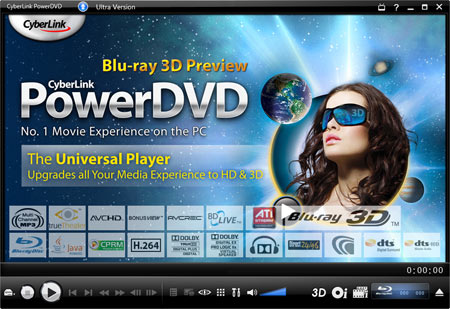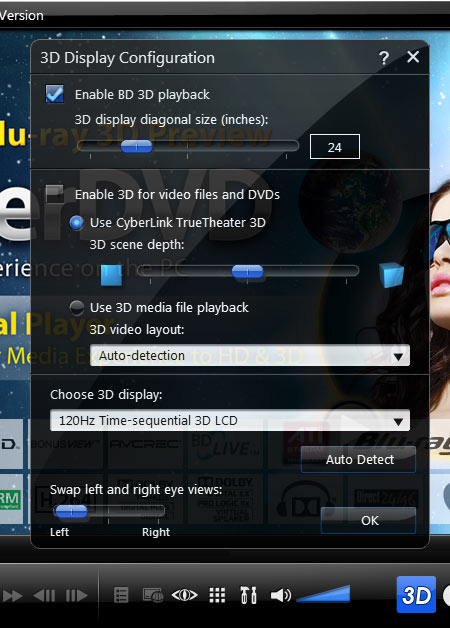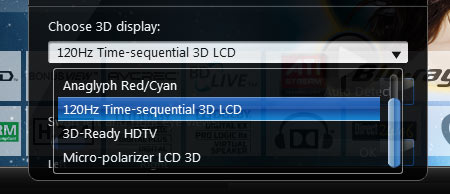Blu-ray 3D On The PC: The Tom's Hardware Review
Tom's Hardware has an exclusive first-look at Blu-ray 3D technology running on a notebook and HTPC leveraging Nvidia's 3D Vision technology, CyberLink's PowerDVD 10 Ultra Mark II software, and an Acer display. Might this setup be in your future, too?
Blu-ray 3D Playback Software
There are four major developers that have announced their intentions to produce Blu-ray 3D playback software: CyberLink, Sonic, ArcSoft, and Corel. CyberLink provided us with a pre-release copy of PowerDVD 10 Ultra Mark II for Blu-ray 3D testing.
Before continuing, we do think it's important to acknowledge the other potential Blu-ray 3D software player providers. We requested preview copies (on admittedly short notice) and ArcSoft responded with a preview copy of TotalMedia Theater 3, while Sonic gave us a preview copy of Roxio CinePlayer BD to try. While both of these builds worked in many respects, some show-stopping bugs indicated that these options are not quite ready for review. However, they do show some promise, and it's good to see they're well into development at this stage. We hope to compare all of the Blu-ray 3D playback options when they're all ready for primetime.
For now, CyberLink's solution appears to be notably ahead of the pack as far as stability is concerned. We will therefore use PowerDVD software to test Blu-ray 3D.
From the look of our preview build, PowerDVD 10 Ultra Mark II continues to use the same basic interface as its predecessors. The one obvious difference is a new button on the bottom-right of the screen labeled, appropriately, 3D. Clicking this brings up the 3D-display configuration:
In the first section of this window, you see the option to turn on Blu-ray 3D playback support. When this checkbox is selected, PowerDVD will allow Blu-ray 3D discs to be played in 3D mode, which is simple enough. The only variable here is the display's diagonal size, which the program seemed to set automatically.
The second section deals with PowerDVD's ability to play back media other than Blu-ray 3D. Most notable here is the option to use CyberLink's TruTheater 3D. When enabled, TruTheater 3D will take a standard 2D DVD or movie source file and extrapolate 3D output in real time. TruTheater 3D uses an in-house-developed algorithm that analyzes the color, position, and movement of objects in the video and renders a stereo 3D interpretation. You can adjust the apparent depth of the 3D effect with the 3D Scene Depth slider
Just to be clear, no 2D-to-3D algorithm is perfect, and the effect is not nearly as good as that of an actual 3D source file from a Blu-ray 3D disc. However, it is an option that some users might enjoy playing with.
Get Tom's Hardware's best news and in-depth reviews, straight to your inbox.
Compared to other 2D-to-3D algorithms we've seen, TruTheater 3D does a passable job. But it's not quite as good as DDD's version that comes with its TriDef Media Player. CyberLink's TruTheater 3D algorithm is still under development, though, so we're not sure how much the software will mature before it's released.
If you'd like to play back an actual 3D media file, you'll need to turn TruTheater 3D off and select “use 3D media file playback.” When left to auto-detect, the program will do its best to figure out the format of the source file (side-by-side, over/under, or anaglyph), or you can set it manually.
The third and final section deals with the display type you are using. For our testing, we'll choose a 120 Hz time-sequential 3D LCD, but there are other half-resolution display options available, such as 3D-Ready DLP (checkerboard), micro-polarizer 3D (interlaced polarized), and even anaglyph red/cyan. This section also holds the important “swap left and right eye view” option. If the 3D effect appears confusing and disorienting, you may need to swap the left and right video channels to set things right. This can be done with a simple slider.
Aside from all of this, the rest of what's needed for Blu-ray 3D playback in PowerDVD 10 Ultra Mark II is done under the hood. With the Enable BD 3D Playback checkbox selected, let's move on and discuss the requirements for a full-resolution Blu-ray 3D PC.
Current page: Blu-ray 3D Playback Software
Prev Page The Other Displays: Half-Resolution Or None At All Next Page Requirements For A Full-Resolution Blu-ray 3D PCDon Woligroski was a former senior hardware editor for Tom's Hardware. He has covered a wide range of PC hardware topics, including CPUs, GPUs, system building, and emerging technologies.



